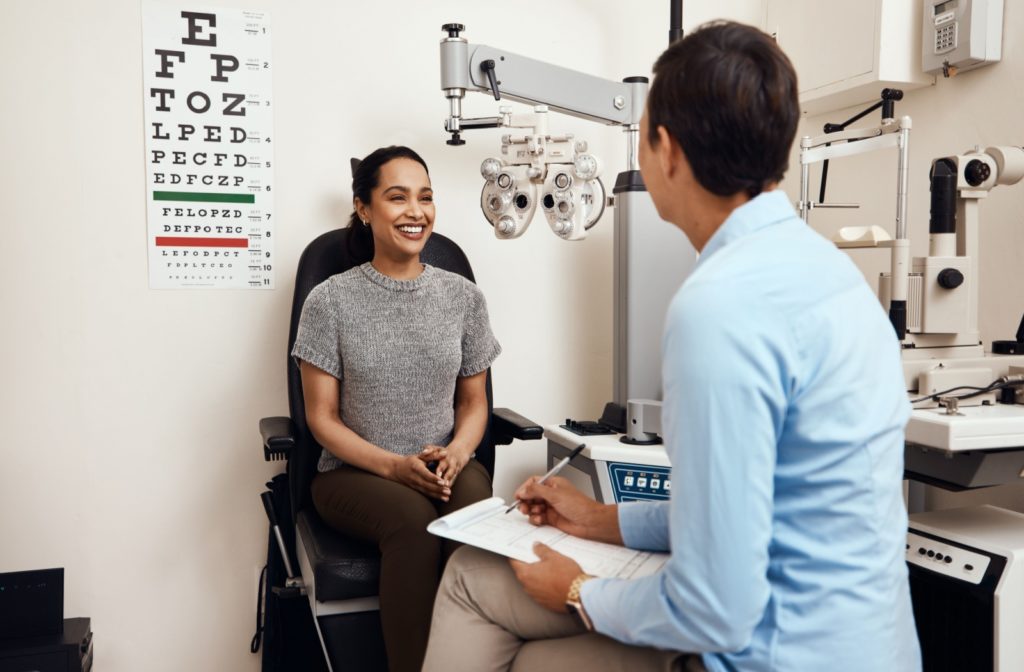At Arena Eyeworks Optometry, we want to keep the nuances of eye care understandable and digestible. When it comes to comprehensive eye exams, our team is dedicated to providing our patients with the information they need to feel comfortable and educated about their eye care. If you have any direct questions about what is included in our comprehensive eye exams, please do not hesitate to contact us — we are always happy to clarify any of your concerns.
What Tests Could be Included in a Comprehensive Eye Exam?
Eye Muscle Test
This evaluation will focus on the muscles that control the movement of your eyes. Your doctor will watch your eyes as they follow a moving object and discern if there are any abnormalities due to muscle weakness, poor control, or poor coordination
Visual Acuity Test
While there are a variety of different methods to test visual acuity, they all perform the same task of evaluating how clearly you can see. The most common test is an eye chart test where you will be asked to read letters on a screen at a set distance one eye at a time. Each row of letters gets smaller as you go down the chart, and once you cannot read the letters anymore your eye doctor will be able to discern your visual acuity.
Refraction Assessment
If your eye does not properly focus light onto your retina, you will experience what is known as a refractive issue. Refractive issues are conditions like myopia, hyperopia, and astigmatism which affect the shape of your lens and cornea causing light to refract improperly through your eye. Refractive issues can be corrected or mitigated through the use of visual aids like eyeglasses and contact lenses, or through refractive surgery.
Your eye doctor may use a device called a phoropter which can help accurately discern what prescription you will need to correct your particular refractive problem. A phoropter is a device containing a wheel of lenses with different magnification levels — your eye doctor will ask you to look through the device and choose which lenses make a stationary image look the clearest in your vision.
Along with visual acuity testing, refractive assessments are the most important tests when it comes to finding a patient’s prescription.

Visual Field Test
Your visual field describes the extent of what you can see without moving your eyes around. A visual field test examines the full extent of your visual field and what areas of your vision you may be having problems with. Types of visual field tests include:
- Confrontation exam — this exam involves your eye doctor asking you to cover one eye while you look straight ahead towards them. Your doctor will move their hand into view, and you will respond every time you see the movement.
- Manual testing — for these tests, you will focus on a target at the center of a screen. An object on screen will move into your peripheral vision every now and then, and you will notify your doctor every time you see an object appear and disappear
- Automated perimetry — in this test, you will be asked to look at a screen with blinking lights on it; every time you see a light blink, you will record it by pressing a button in front of you
Color Vision Test
If you have a hard time distinguishing the difference between certain colors, you can ask your doctor for a color vision test to screen for a color deficiency. In this test, you will be asked to look at different dot patterns with different colors — in the middle of the pattern there will be a shape or symbol that will be discernable to those without a color deficiency.
The most common form of color blindness among people who developed a deficiency at birth is the congenital variety, which means they have difficulty distinguishing between the red and green spectrum. People affected by diseases like glaucoma or optic nerve disease usually cannot distinguish between blue and yellow.
Testing Your Pupils
Your eye doctor may check your pupils and how they respond to light — usually, pupils will get smaller in bright lighting conditions and dilate when it is dark. If your pupils stay the same in varying conditions or do not act appropriately for the condition, it may be a signifier of other underlying visual problems.
Retinal Examination
This type of examination, including ophthalmoscopy or funduscopy, allows your doctor to evaluate the back of your eye. Usually, your eyes will be dilated if your doctor chooses to perform a retinal examination. After the dilating eye drops take effect, your eye doctor may use one or more of the following procedures to view the back of your eye:
- Direct exam — an ophthalmoscope is used to shine light through your pupil so your eye doctor can see the back of your eye, allowing them to accurately examine your retina and other structures.
- Indirect exam — this test involves your eye doctor examining the inside of your eye with a condensing lens and a mounted light while you are reclined in a chair. During this test, your eye doctor will be able to see the retina and other structures inside your eye in great detail.



